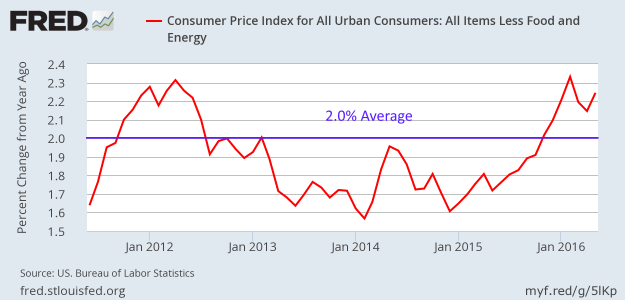Summary: Let’s look at the four key measures of growth for the US economy. They show the big news about this economic cycle: six years of amazing stable and slow US growth, shrugging off repeated shocks. This has surprised almost everybody, and proven most forecasters wrong. There are important lessons we should learn from this.
Real GDP: Slow GDP growth since Q1 2010 with only ½% swings around the average.
Per capita GDP, a better measure of how well we’re doing, has grown only 1.8%/year.

Nonfarm payrolls: slow stable job growth since September 2011 with only ½% swings around the average.

Very low and stable core inflation since June 2011, varying only ⅖% from the average.

Here’s another perspective on employment: total hours worked for production and nonsupervisory employees in the private sector (80% of all private sector workers). It provides a better metric of the labor component of economic growth than the number of jobs (which can be one hour per week — or 50). It also shows slow steady growth.

Conclusions
Remember all the headlines in the past six years about economic political shocks to America? Massive, traumatic, even irresistible shocks! How many times has Zero Hedge has announced the beginning of the End Times? Quarterly? Monthly?
The results on the US economy: small drops followed by fast recoveries. These are tiny swings compared to the usual fluctuations in the post-WWII era. The cause is not obvious. The QE3 monetary stimulus ended in October 2014. The Federal budget deficit has decreased as a percent of GDP every year since 2014.
The bottom line is that the US is locked into a stable slow growth mode. The long anticipated acceleration (a return to the good old days) has disappointed the optimists. The stability has surprised the pessimists. The doomsters are, as usual, delusionally wrong.
This expansion is 84 months long, the sixth longest since 1857 (when NBER began dating them). More relevantly, it is the fourth longest of the twelve cycles since WWII. The Atlanta Fed’s GDPnow model estimates Q2 was +2.4%, implying no recession on the visible horizon. The strong June jobs growth confirms that. The Chauvet-Piger model continues to predict an accelerating recovery (as it has since the recovery ended in June 2009).
Since there is no such thing as a “stall speed”, another dip will not cause a recession (i.e., the economy is not like an airplane, and has no minimum speed below which it crashes). The economy has grown too slowly to overheat or develop serious imbalances. What might cause the next recession? And when? Nobody knows. We have entered a new era, and the old “clocks” that show the business cycle no longer work. We are sailing an unknown sea without a compass.
What about the confident predictions that generate clickbait headlines on research reports, websites, and newsletters? Most have been wrong for many years (or changed their forecasts with the wind). People read them because they need the illusion of understanding, not because they have been correct — or that we have any basis to believe they will be correct soon.
Embrace the uncertainty. Plan for many possibilities in the next few years.
